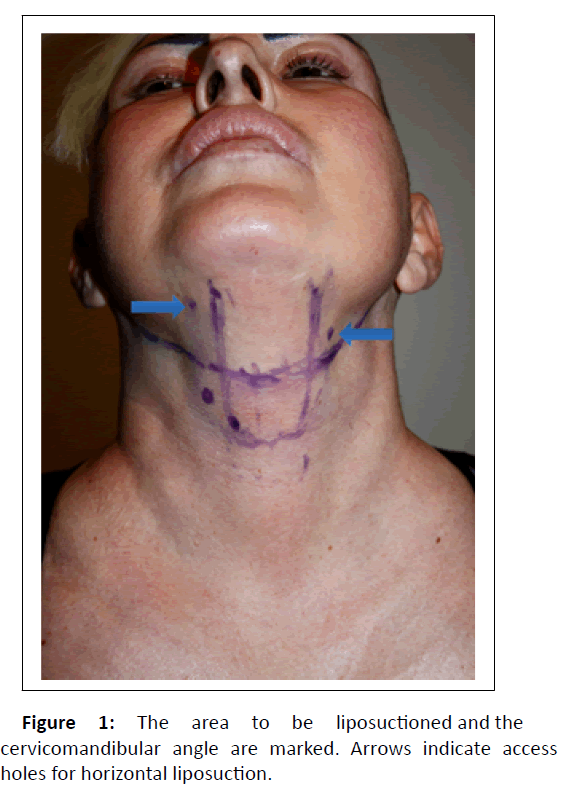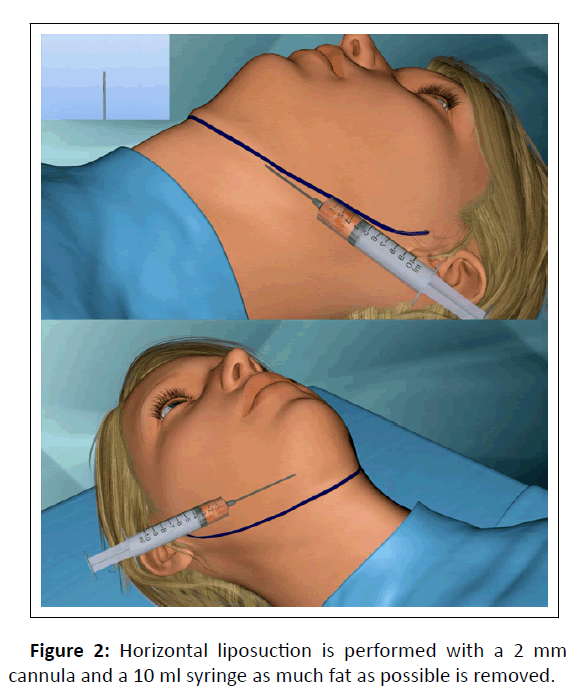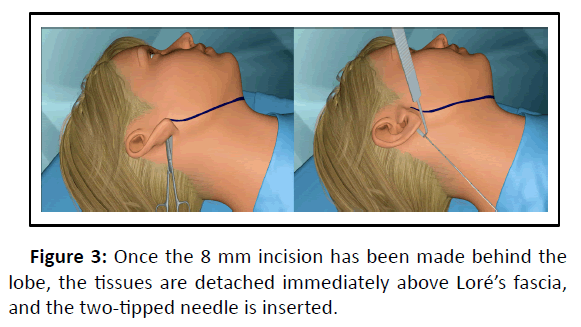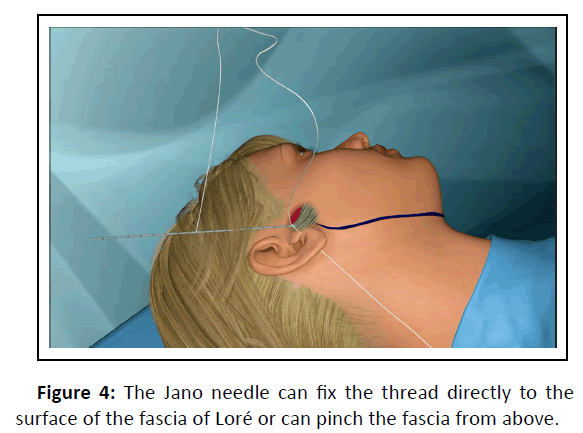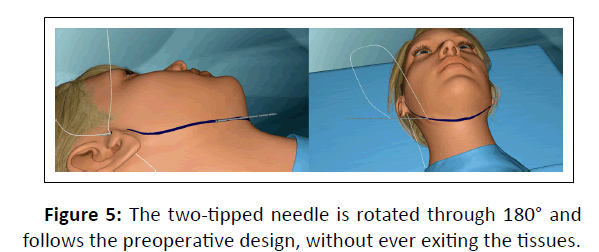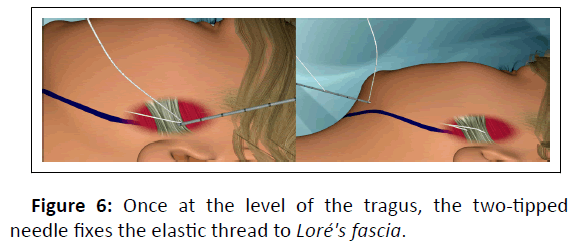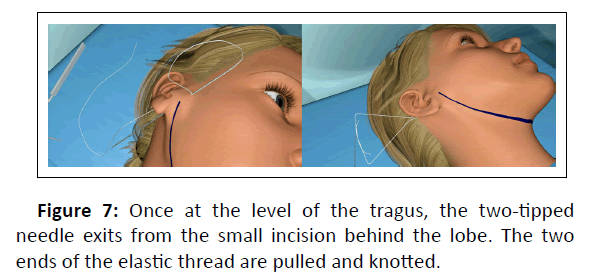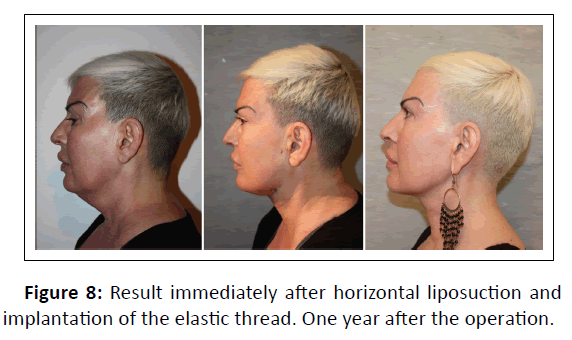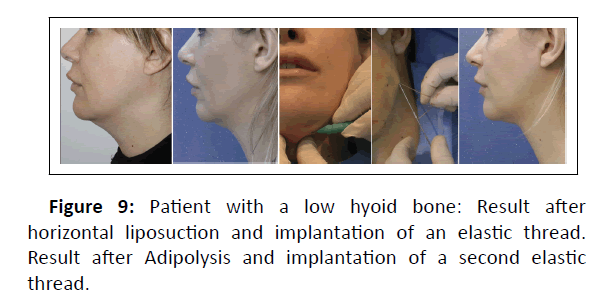Liposuction of Double Chin and Elastic Neck Lifting
Sergio Capurro*
Department of Plastic Surgery, Capurro Clinic, Genoa, Italy
Published Date: 2022-06-10DOI10.4172/2472-1905.100149
Sergio Capurro*
Department of Plastic Surgery, Capurro Clinic, Genoa, Italy
- *Corresponding Author:
- Sergio Capurro
Department of Plastic Surgery,
Capurro Clinic, Genoa,
Italy,
E-mail: sergio.capurro@hotmail.it
Received date: May 11, 2022, Manuscript No. IPARS-22-13835; Editor Assigned date: May 13, 2022, PreQC No. IPARS-22-13835 (PQ); Reviewed date: May 24, 2022, QC No. IPARS-22-13835; Revised date: June 3, 2022, Manuscript No. IPARS-22-13835 (R); Published date: June 10, 2022, DOI: 10.4172/2472-1905.100149
Citation: Capurro S (2022) Liposuction of Double Chin and Elastic Neck Lifting. J Aesthet Reconstr Surg Vol.8 No.3: 149.
Abstract
Background: Correcting a double chin frequently requires liposuction. The desired result is a well-defined neck without fatty deposits. This result is never achieved by means of liposuction alone. Even if liposuction is combined with traditional neck lifting, the result is often modest and is never stable over time. A new elastic suture enables a new surgical technique to be implemented.
Methods: Our technique involves horizontal liposuction of the double chin through a 2 mm cannula and simultaneous implantation of an elastic suspension thread (Elasticum EP 3,5 Korpo) between the two fasciae of Loré, by means of a two-tipped needle, through an 8 mm incision behind one earlobe. This impalpable elastic thread does not cut into the tissues, and when colonized by connective cells, becomes an "integrated ligament".
Results: The result is immediately visible and permanent.
Conclusion: Horizontal liposuction and the simultaneous implantation of an elastic thread is a simple procedure that yields excellent definition of the cervicomandibular angle. In difficult cases, for example in patients with a low hyoid bone, it is possible to further improve the neck by implanting an additional thread, with minimal trauma.
Keywords
Double chin; Submental liposuction; Elastic neck lift; Elastic suture; Neck rejuvenation
Introduction
A double chin is frequently hereditary. The accumulation of sub mental fat causes the cervico-mandibular angle to disappear or makes it obtuse. Weight loss diets have little effect. To improve the aesthetics of the neck, patients aged between 20 and 50 years with double chins often undergo liposuction. This eliminates fat deposits but is unable to create a well-defined cervico-mandibular angle. Indeed, liposuction alone yields modest results [1,2]. Moreover, these young patients are unwilling to simultaneously undergo the trauma of traditional neck lifting. Submentoplasty with platysma plication is also ineffective, and ptosis of the neck recurs [3,4].
By contrast, these patients are always willing to undergo horizontal liposuction and simultaneous implantation of an elastic thread through an 8 mm skin incision behind one ear lobe. This neck lift has been made possible by the invention of the two-tipped needle and elastic thread [5-7].
Materials and Methods
Horizontal neck liposuction is performed with a 2 mm cannula through two tiny ports. After liposuction, an elastic thread is implanted in order to outline the cervico-mandibular angle. The elastic suture (Elasticum EP3.5), mounted on a two-tipped needle (Jano needle), is fixed to the two fasciae of Loré through an 8 mm incision behind one earlobe.
This impalpable elastic thread, which is made of polyestercoated silicone, does not cut into the tissues, and, once colonized by connective cells, becomes an “integrated ligament”.
Preoperative design
The area to be liposuctioned is identified by means of palpation and is drawn with a dermographic pen (Figure 1). Two access points are marked out, one higher and one lower, in order to perform horizontal liposuction.
The skin at the corners of the mandible is lifted with the hands and the patient is asked to bend his/her neck, so that the corners of the cervicomandibular angle can be drawn.
The line of the design passes externally to the corners of the mandible and stops at the level of the fascia of Loré on both sides.
Local anaesthesia
A quantity of 0.5 mg of adrenaline is placed in a 10 ml vial of 2% mepivacaine. The local anaesthetic is injected behind the lobe of the ear where the access incision will be made and into the two preauricular regions above Loré’s fascia. A wheal of concentrated anaesthesia is also created at the two access points of the liposuction. 1 mg of adrenaline is placed in a second 10 ml vial of 2% mepivacaine; 5 ml of this latter anaesthetic solution drawn into two 20 ml syringes, which are then filled with lactate Ringer's or saline solution. This diluted anaesthetic solution is injected along the pathway of the thread and into the area that will be liposuctioned.
Surgical procedure
Horizontal liposuction of the double chin is carried out through two lateral accesses. The accesses can be created with a 16 g needle and dilated with the fine tip of a Klemmer. The fat under the chin will be aspirated through the upper access, while the lower access will enable the operator to aspirate the fat located beneath the cervicomandibular line. The aspiration cannula has a diameter of 2 mm. A 10 mL syringe is used to aspirate the fat (Figure 2).Once liposuction is complete, elastic neck lifting is performed. The elastic thread is implanted through an 8 mm incision behind the lobe of one ear.
The tissues immediately above the fascia of Loré are dissected with scissors. The dissected tissues are lifted with a retractor, and an elastic thread (Elasticum EP 3.5), equipped with a twotipped Jano needle, is inserted into the cavity (Figure 3). Immediately below the ear, the two-tipped needle fixes the elastic thread to Loré’s fascia either directly or from above. In this case the Jano needle is extracted until 1 cm of its posterior tip remains in the tissues.
The needle is placed vertically and advances until it touches the fascia; it then tilts and superficially crosses the fascia. A short fixation is sufficient (Figure 4). After fixing the thread to the fascia, the Jano needle follows the preoperative design, partially emerging from the skin below the mandibular angle. When 1 cm of the posterior tip remains in the tissues, the Jano needle is rotated. The posterior tip then becomes anterior, and the needle follows the design of the cervicomandibular angle (Figure 5).
The operator must remember to attach a Klemmer to the end of the elastic thread. At each 180° rotation, the Jano needle is partially extracted, and the elastic thread is pulled through. The depth-marks on the shaft of the needle are counted. The elastic thread is normally implanted at a depth of 1 cm along the vertical pathways and about ½ cm along the horizontal ones. The more superficially the thread is implanted, the more acute the cervicomandibular angle becomes. If the pathway of the needle is too superficial, a skin introflexion is formed. If this happens, the operator must pull the needle back and reposition the thread at the correct depth, in the subcutaneous tissue. During its travel, the two-tipped needle must never be completely extracted from the skin.
The Jano needle partially emerges at the level of the tragus. The operator counts the depth-marks. When 1 cm of the tip remains in the tissues, the needle rotates in the vertical direction and advances until it reaches the fascia; it then tilts superficially, penetrates the fascia of Loré and follows a pathway located about 1 cm above the previous one. The two-tipped needle partially emerges in proximity to the angle of the mandible.
The operator tugs on the thread several times to ensure that it is firmly anchored to the fascia of Loré. The depth-marks on the needle are counted; when ½ cm of the tip remains in the tissues, the needle is rotated through 180°and continues along its pathway, avoiding the access used for liposuction (Figure 6). The two-tipped needle partially emerges in front of the tragus. The elastic thread is placed under tension. The operator counts the depth-marks. When 1 cm of the tip remains in the tissues, the Jano needle is rotated in the cavity, which has been kept open by the retractor and emerges from the initial incision behind the earlobe. The two ends of the elastic thread are placed under tension and knotted (Figure 7). The operator sutures the small incision with an absorbable thread. A containment bandage will be worn by the patient for two weeks. The cervicomandibular angle is now well defined.
Results
Six months later, the effectiveness of the procedure is assessed. In 22 of 23 our patients treated with this technique, the cervicomandibular angle remained well defined and stable after years, even in the case of weight loss (Figure 8). Only in one patient was the cervicomandibular angle not perfectly defined. This was due to the fact that a low hyoid bone hindered the creation of a more aesthetic angle [8,9]. In such cases, the adipocytes present are further reduced by means of a physical method (Adipolysis) and a second elastic thread is implanted between the two fasciae of Loré through an incision behind the contralateral lobe (Figure 9).
Discussion
This operation is perfectly tolerated by patients, who can resume their normal activities almost immediately. Horizontal liposuction through a small-calibre cannula causes retraction of the tissues of the neck, which is essential to obtaining the desired result. In the past, this procedure would have terminated with liposuction; the patient would have worn a compressive bandage for some weeks and the result would have been seen a few months later. Liposuction alone yields modest results. Today, implanting the elastic thread between the two fasciae of Loré enables us to restore the cervicomandibular angle immediately, and the result is permanent. The jaw also becomes well delineated. Elastic suspension eliminates the weight of the underlying tissues, thereby enabling the tissues that have undergone liposuction to retract completely and rapidly. Liposuction must be as complete as possible. For this reason, when you think you have finished, you should ask an assistant to perform another hundred passages of the cannula. During liposuction, it is preferable to avoid bleeding; for this reason, the local anaesthetic solution contains a fair amount of adrenaline. Liposuction and elastic neck lifting correct a double chin in young people and in patients aged over 50 years who do not have very sagging neck skin. We also frequently perform horizontal liposuction in neck lifts carried out in elderly patients with excess skin. In these patients, it is necessary to evaluate drooping of the cheeks, which is corrected by means of elastic MACS lifting [10,11]. This involves creating three suspension triangles, without dissection of the cheeks, and removal of the temporal skin at the sideburn. Lifting the cheek volumes also lifts the sagging tissues of the neck. If neck sagging persists, it is corrected a few months after elastic MACS lifting. In these patients, three elastic sutures are implanted along the cervicomandibular line after double chin liposuction: Two through an incision behind the lobes of both ears and one, central anterior, through two 16 G needle holes. This configuration of elastic threads enables the vertical and horizontal wrinkles of the neck to be smoothed out, without any dissection and without removing the skin.
Conclusion
Horizontal liposuction through a 2 mm cannula and the immediate implantation of an elastic thread between the two fasciae of Loré is a simple and effective technique for obtaining a well-defined cervicomandibular angle in young patients. In elderly patients, the invention of the two-tipped needle and the elastic thread enables aesthetic neck surgery to be undertaken according to new concepts. The tissues are simply repositioned by means of elastic threads; dissections and traumatic manipulations are no longer needed.
References
- Marten T, Elyassnia D (2018) Neck lift: Defining anatomic problems and choosing appropriate treatment strategies. Clin Plast Surg 45: 455-484.
[Crossref], [Google Scholar], [Indexed]
- Gryskiewicz JM (2003) Submental suction-assisted lipectomy without platysmaplasty: Pushing the (skin) envelope to avoid a face lift for unsuitable candidates. Plast Reconstr Surg 112: 1393-405.
[Crossref], [Google Scholar], [Indexed]
- Perkins SW, Gibson FB (1993) Use of submentoplasty to enhance cervical recontouring in face-lift surgery. Arch Otolaryngol Head Neck Surg 119: 179-183.
[Crossref], [Google Scholar], [Indexed]
- Balaji SM, Balaji P (2020) Plication of neck strap muscles and platysma for double chin correction-A retrospective study. Ann Maxillofac Surg 10: 417-421.
[Crossref], [Google Scholar], [Indexed]
- https://www.capurro.net/it/elastic-plastic-surgery
- Sheathed elastic surgical thread (2006)
- Nontraumatic two-point needle for surgical suture (2006)
- Marino H, Galeano EJ, Gandolfo EA (1963) Plastic correction of double chin. Importance of the position of the hyoid bone. Plast Reconstr Surg 31: 45-50.
[Crossref], [Google Scholar], [Indexed]
- Yousif NJ, Matloub HS, Sanger JR (2016) Hyoid suspension neck lift. Plast Reconstr Surg 138: 1181-1190.
[Crossref], [Google Scholar], [Indexed]
- https://www.korpo.com/news/elastic-macs-and-neck-lift-without-dissection-of-the-cheeks-and-neck/
- https://www.crpub.org/elastic-plastic-surgery/item/121-51-elastic-macs-lift-and-elastic-canthopexy.html
Open Access Journals
- Aquaculture & Veterinary Science
- Chemistry & Chemical Sciences
- Clinical Sciences
- Engineering
- General Science
- Genetics & Molecular Biology
- Health Care & Nursing
- Immunology & Microbiology
- Materials Science
- Mathematics & Physics
- Medical Sciences
- Neurology & Psychiatry
- Oncology & Cancer Science
- Pharmaceutical Sciences
